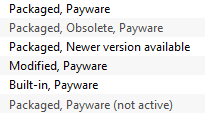The information in this Wiki Page applies to TRS19 and Trainz Plus. This page is intended to provide information for understanding the different asset Status labels used by Content Manager.
Content Manager Status
Start Content Manager by clicking Manage Content from the Trainz Launcher.
The Status column in the Content Manager display gives information about each listed assets location, availability, and its "currency" (installed, obsolete, modified, Payware, unknown, etc).
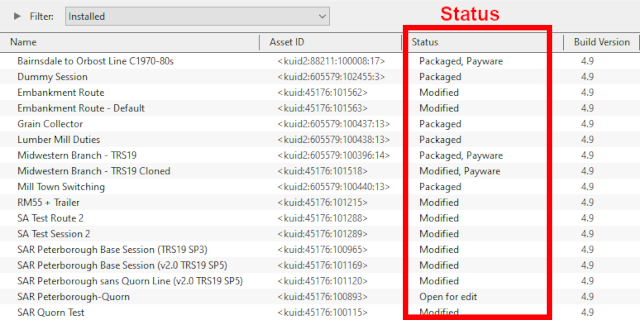 |
 |
If the Status column is not present in the Content Manager display, then:-
- right mouse click on the column heading where you want it to be inserted
- select Insert Column and then Status
 |
| |
Columns in Content Manager can be:-
- Right mouse click on a column heading and select Remove Column
- Hold down the left mouse button on a column heading and drag it left or right
- Move the tip of the mouse pointer onto the dividing line between two column headings, hold down the left mouse button and drag it left or right
|
|
The Status labels are described in the following sections.
Available for Download
This modified search filter will show all the freeware assets including their different versions that are available on the Download Station (DLS). Set the Content Manager search filter to Download Station and edit as shown below.
- Open the filter (click the small triangle pointer on the left of the word Filter:)
- Remove (click the (-) buttons on the extreme right) of the filter lines:-
-
You can save this as a new filter
- Click the Save button (which will appear as soon as you delete one of the filter lines)
- Give the new filter a name (e.g. Available for Download)
Once saved you can reuse the filter whenever needed.
|
 |
|
The filtered list will show all the assets except Payware that are available on the DLS. The Status labels that you may see would be:-
|
|
 |
The Status label "Newer version available" means that a later version of that asset can be downloaded and installed |
 |
The Status label "Obsolete" means that a later version of that asset is already installed in Content Manager |
|
| Available for download |
This IS the latest version available on the DLS and it is not already installed on your system. If you are looking to install a new asset or update an existing one, then this is the one you would normally select |
| Available for download, Newer version available |
This is NOT the latest version available on the DLS and this particular version is not already installed on your system. There is an update to this version available on the DLS |
| Available for download, Obsolete |
This is NOT the latest version available on the DLS and this particular version is not already installed on your system. There is an updated version already on your system but it may not be the latest version |
You can download and install an earlier (older or Obsolete) version if you want to - right mouse click on the version you want and select Download this version.
You can also check to see the latest version of an asset that is listed as Newer version available or Obsolete.
- right mouse click on the asset
- select the command List Asset Versions
The list can be sorted into alphabetical/numerical order using a particular column by clicking on the column heading.
- first click - A to Z, 1 to 9
- second click - Z to A, 9 to 1
- third click - same as first click, etc
|
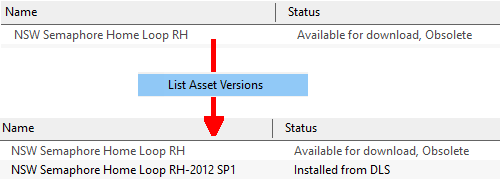 |
|
In this case the latest version of the selected asset is already installed on your system (Installed from DLS) and it does not have exactly the same name as the original.
If the latest version is not installed on your system then it will show Available for download.
Installed
This search filter will show all the assets that are installed in Content Manager. Set the Content Manager search filter to Installed. The Status labels that you may see would be:-
[For simplicity only the major labels are shown in the figure below]
|
|
 |
The Status "Newer version available" added to a label means that a later version of that asset can be downloaded and installed |
 |
The Status "Obsolete" added to a label means that a later version of that asset is already installed in Content Manager |
 |
An asset that was originally Base, Built-in or Packaged can be changed to Installed from DLS by installing a newer version from the DLS |
|
| Modified |
The asset is one you have created yourself, or have modified or cloned from another asset |
| Built-in |
The asset was installed when Trainz was installed on your system. Built-in assets cannot be deleted |
| Packaged |
The asset is included in a DLC package that you have installed. See the  Packaged and Payware section below Packaged and Payware section below |
| Installed from DLS |
The asset was installed from the DLS |
| Base |
The asset was installed when Trainz was installed on your system. Like Built-in assets, Base assets cannot be deleted |
 |
Notes:
 |
You can delete assets that are labelled as Installed from DLS, Obsolete |
 |
You cannot delete assets that are labelled as Built-in, Obsolete or Base, Obsolete |
|
Third Party
You may occasionally see the following label on installed assets:-
This will appear on assets that:-
- you have uploaded to the DLS but they have not yet been approved for distribution. Usually it takes 24 hours (sometimes more) before approval is given. After approval the Third Party label will be changed to Installed from DLS
- have been removed from the DLS listing, for a variety of reasons:-
- if the reason was copyright violation then the assets will no longer be available to anyone who had not already downloaded and installed them before they were removed. If you had downloaded them then they will appear as Third Party in your Content Manager. If you include them in an uploaded Route then they will appear as <unknown assets> in the Content Manager of users who have downloaded your Route but do not already have the assets.
- if the reason is repair work then they can still be downloaded and installed, as Third Party assets, and the repaired assets will (eventually) become available as normal Newer version available updates.
- in some circumstances a removed asset might still be downloaded as a dependency of another asset but not as an individual asset in its own right. It will receive the label Third Party once downloaded.
Disabled
You may occasionally see the following label on installed assets:-
|
|
Disabled
The asset has been manually Disabled (from the Content menu select Disable). |
Disabling assets will "hide" them from other assets, including Routes and Sessions, so they cannot be used. It is a useful technique for deleting troublesome assets from a Route or Session without actually deleting the assets themselves. For an example of this see  Deleting Stubborn Scenery Assets. Normally you would restore the Disabled assets after fixing the Route or Session (from the Content menu select Enable).
Deleting Stubborn Scenery Assets. Normally you would restore the Disabled assets after fixing the Route or Session (from the Content menu select Enable).
Payware assets that are Disabled will have Payware (not active) as their status label.
Open for Edit
|
|
Open for edit
The asset is currently in use by another process such as Surveyor, Driver or Content Manager. |
This label will appear on any asset that you have:-
- currently open in Surveyor (a Route that is being edited) or Driver (a Session that is running)
- opened in Content Manager for editing
- imported into Content Manager from a Content File (.cdp file) or a Content Folder when the same asset is already installed
In the first case, exiting Surveyor or Driver will close the open Route and Session assets.
In the second and third cases you will need to manually close the open assets.
- select the open assets (individually or as a group)
- right mouse click on an open asset
- select the Submit Edits command to close them with the edits saved, or
- select Revert to Original to cancel the edits and return the assets to their previous unedited states
|
|
 |
Notes:
 |
Assets that are Open for edit cannot be exported to a .cdp file. They must be closed first |
 |
If Trainz unexpectedly closes while using Surveyor or Driver, such as a Crash To Desktop or it is terminated by Task Manager, then the loaded Route and Session will be Open for edit when you restart Trainz. See the Trainz Wiki Page  Route and Session Basics for more information on dealing with this situation Route and Session Basics for more information on dealing with this situation |
|
Not Installed
Set the Content Manager search filter to All Content and click the Status column heading (once or twice) to sort the very long list according to their Status labels. Scroll down the list and you may see:-
Unknown Location
 |
The Status label "Unknown location, Obsolete" means that a later version of that asset is already installed in Content Manager |
|
|
Unknown location
The asset is listed as being on the DLS but it is currently unavailable |
 |
If the asset is simply labelled as Unknown location then try the following:-
- right mouse click on the asset
- select List Asset Versions
You may find a later version is Available for download
 |
Incompatible
|
|
Incompatible
The asset is designed for a more recent version of Trainz than you are currently using. |
The Build Version column will identify the minimum Trainz build that the asset needs.
 |
To display the Build Version column in Content Manager:-
- right mouse click on any column heading where the new column will be inserted
- select Insert Column and then
- select Build Version
|
| |
 |
| |
A list of all the Trainz Build Version Numbers with their corresponding Trainz Version Names and service pack numbers can be found at  "Trainz-build"_number "Trainz-build"_number |
Not Installed
|
| Not installed, Payware (not active)
The asset is in a DLC package and must be installed using the Content Store option from the Trainz Launcher |
Packaged and Payware
Some of the Status labels that can appear on Package and Payware assets are:-
|
|
 |
The Status label "Newer version available" means that a later version of that asset can be downloaded and installed |
 |
The Status label "Obsolete" means that a later version of that asset is already installed in Content Manager |
 |
An asset that was originally Base, Built-in or Packaged can be changed to Installed from DLS by installing a newer version from the DLS |
|
| Packaged |
The asset is included in a DLC package that you have installed. See Notes: below |
| Payware |
The asset is part of a payware package (usually from the DLC). Most DLC Payware can be modified for your personal use (the Status label "Modified" will be added) but cannot be uploaded to the DLS. Exactly which assets in a package are Payware and which are Packaged (freeware) is determined by the creator of the package. See Notes: below |
| Payware (not active) |
The asset is part of a payware package that is no longer active on your system. You may have uninstalled the package, disabled it, or it may have been installed for a free trial period which has now expired |
Missing Dependencies
This is a label to be avoided.
|
|
Missing dependencies
The asset relies on the presence of other assets (dependencies) that must be installed on your system and at least one of those assets has not been installed. |
The first thing to check is to see if the missing asset or assets can be identified.
- Right mouse click on the asset
- select the command List Dependencies
All the assets that are required by this asset will be identified.
|
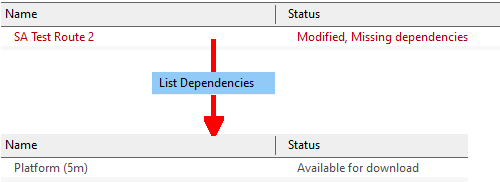 |
|
In this case, the Missing dependency is shown as Available for download so it is on the DLS and can be installed to fix the problem. If there are several assets that are listed as Available for download, select and download them all.
This situation can occur if you have deleted the asset without realising that it is needed in other assets, such as a Route or a Session.
 |
To avoid the possibility of accidentally deleting an asset that is a dependency of other assets:-
- right mouse click on the asset to be deleted
- select the command List Dependants
This will give a list of all other assets that use the selected asset. |
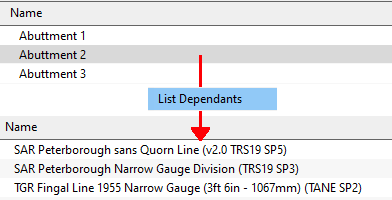 |
|
Unknown Asset
A more serious problem can be the unknown asset.
|
|
unknown asset
The asset cannot be found on your system or on the DLS. |
The label "<unknown asset>" will shown in the Name column and the Status column will be blank.
<unknown assets> can often appear when using the List Asset Versions command on a selected asset.
 |
In this example the first and original version of the asset (<kuid:122285:1161>) is available on the DLS but is now Obsolete. The latest and fourth version (<kuid2:122285:1161:3>) is labelled as Packaged and is installed in Content Manager but is also available on the DLS. But the two intermediate versions (:1 and :2) are unknown assets and are not available. They may have been created but never uploaded to the DLS. If they had been uploaded then they would have been made Obsolete by the latest version.
It is not unusual for asset creators to leave "gaps" in the Asset ID update numbers (the trailing ":digit" in the <kuid>) during the development process. |
Apart from the example above, unknown assets are almost always dependencies of other assets that you have downloaded and installed. The installed assets would be labelled has having Missing dependencies.
 |
Note:
Having an <unknown asset> is not necessarily a problem. If an installed asset with an unknown asset as a dependency is not classified as Faulty then it can often be ignored. A Route, for example, can be labelled as having missing unknown assets but still function perfectly well.
|
The unknown asset may:-
- be from an independent (3rd party) web site
- have been made by the same creator as the dependent asset but was not uploaded to the DLS
- have been removed from the DLS for some reason (a rare event but it does happen)
- simply not exist, anywhere
Fixing this may not be easy. Possible solutions are:-
- There is a very long thread in the Trainz Forum where you can find posts looking for missing/unknown assets. See
 Missing kuids? Post them here
Missing kuids? Post them here
- You can try contacting the creator via email (their address may be in the config.txt file) or a PM (Personal Message) through the Forum
Neither is a guaranteed solution.
If the unknown asset is in a Route or a Session then a third option is to use the Delete Missing Assets command from the Tools menu in Surveyor, but make a backup copy of the Route or Session first.
Trainz Wiki
 |
More Tutorials and Guides to Using Trainz
|
This page was created by Trainz user pware in January 2022 and was last updated as shown below.

Deleting Stubborn Scenery Assets. Normally you would restore the Disabled assets after fixing the Route or Session (from the Content menu select Enable).



Missing kuids? Post them here







